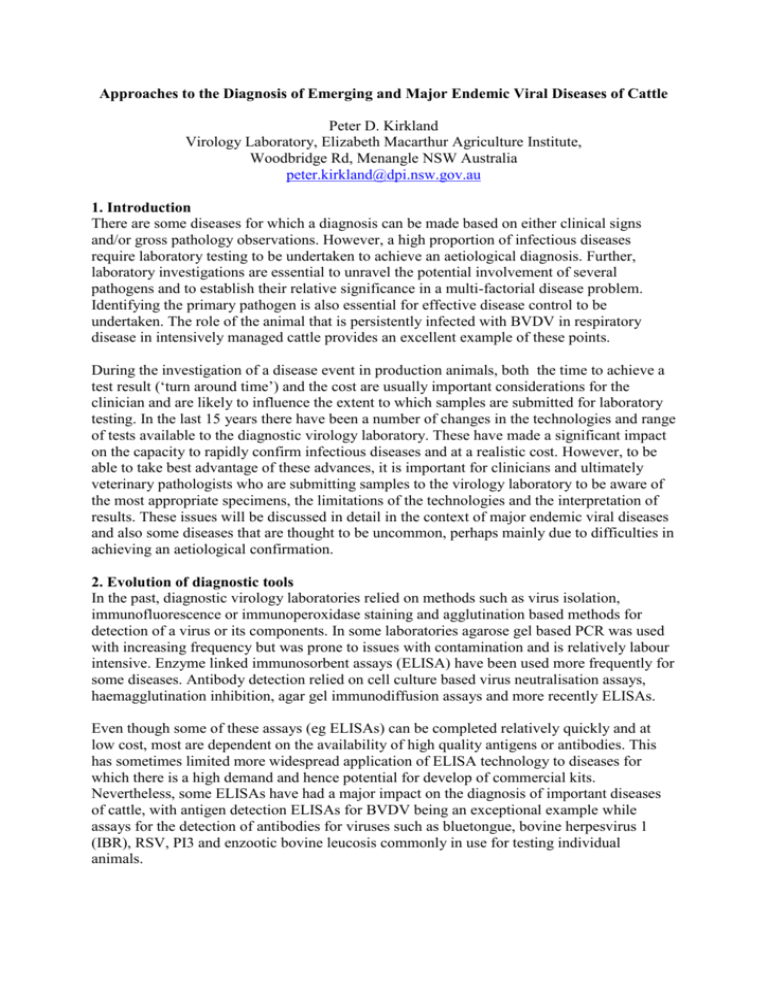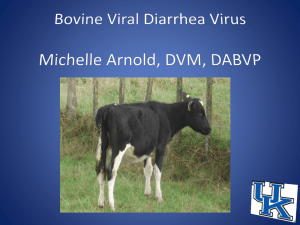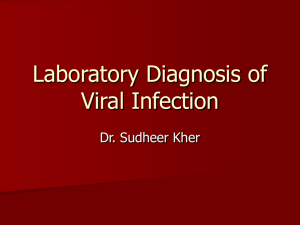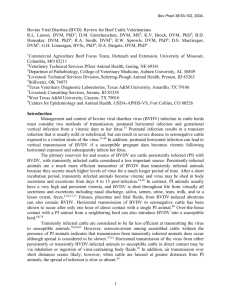Approaches to the Diagnosis of Emerging and Major Endemic Viral
advertisement

Approaches to the Diagnosis of Emerging and Major Endemic Viral Diseases of Cattle Peter D. Kirkland Virology Laboratory, Elizabeth Macarthur Agriculture Institute, Woodbridge Rd, Menangle NSW Australia peter.kirkland@dpi.nsw.gov.au 1. Introduction There are some diseases for which a diagnosis can be made based on either clinical signs and/or gross pathology observations. However, a high proportion of infectious diseases require laboratory testing to be undertaken to achieve an aetiological diagnosis. Further, laboratory investigations are essential to unravel the potential involvement of several pathogens and to establish their relative significance in a multi-factorial disease problem. Identifying the primary pathogen is also essential for effective disease control to be undertaken. The role of the animal that is persistently infected with BVDV in respiratory disease in intensively managed cattle provides an excellent example of these points. During the investigation of a disease event in production animals, both the time to achieve a test result (‘turn around time’) and the cost are usually important considerations for the clinician and are likely to influence the extent to which samples are submitted for laboratory testing. In the last 15 years there have been a number of changes in the technologies and range of tests available to the diagnostic virology laboratory. These have made a significant impact on the capacity to rapidly confirm infectious diseases and at a realistic cost. However, to be able to take best advantage of these advances, it is important for clinicians and ultimately veterinary pathologists who are submitting samples to the virology laboratory to be aware of the most appropriate specimens, the limitations of the technologies and the interpretation of results. These issues will be discussed in detail in the context of major endemic viral diseases and also some diseases that are thought to be uncommon, perhaps mainly due to difficulties in achieving an aetiological confirmation. 2. Evolution of diagnostic tools In the past, diagnostic virology laboratories relied on methods such as virus isolation, immunofluorescence or immunoperoxidase staining and agglutination based methods for detection of a virus or its components. In some laboratories agarose gel based PCR was used with increasing frequency but was prone to issues with contamination and is relatively labour intensive. Enzyme linked immunosorbent assays (ELISA) have been used more frequently for some diseases. Antibody detection relied on cell culture based virus neutralisation assays, haemagglutination inhibition, agar gel immunodiffusion assays and more recently ELISAs. Even though some of these assays (eg ELISAs) can be completed relatively quickly and at low cost, most are dependent on the availability of high quality antigens or antibodies. This has sometimes limited more widespread application of ELISA technology to diseases for which there is a high demand and hence potential for develop of commercial kits. Nevertheless, some ELISAs have had a major impact on the diagnosis of important diseases of cattle, with antigen detection ELISAs for BVDV being an exceptional example while assays for the detection of antibodies for viruses such as bluetongue, bovine herpesvirus 1 (IBR), RSV, PI3 and enzootic bovine leucosis commonly in use for testing individual animals. While there has been a gradual evolution of testing technologies, the greatest step forward has come through the widespread adoption of real time PCR (qPCR, or for RNA detection, qRTPCR). Real time PCR offers numerous benefits for application to diagnostic investigations. These include turn around time, high analytical and diagnostic sensitivity, a capacity to test samples of inferior quality and usually over a longer time frame during the course of a disease compared to virus isolation. There are many other opportunities to capitalise on the power of this technology and is limited mostly by the creativity of laboratory scientists. There is considerable merit in re-investigating the biology of a disease of interest as this may provide a foundation for selection of alternative sample types (eg hair, skin, milk or body fluids) and provide data that is needed to establish the practicality of sample pooling. qPCR is also highly prescriptive and new assays can be readily adopted/transferred to other laboratories. The capacity for multiplexing of real time PCR assays (ie testing for multiple agents on the same sample and in the sample test) provides an efficient method for the investigation of disease syndromes. There is also a variation on multiplexing – referred to as multitasking whereby several different assays are run under uniform conditions at the same time and on the same test plate. Both multiplexing and multitasking provide considerable economies of scale, on one hand reducing the cost of assays for individual samples and significantly reducing ‘turn around’ time – allowing most tests to be completed on a ‘same day’ basis. These new technologies have greatly enhanced the capacity of diagnostic laboratories, allowing provision of a test capacity for an uncommon disease. This has allowed more frequent laboratory confirmation of apparently uncommon diseases (eg BMC) or rapid confirmation of acute diseases (eg BEF) for which there were either no agent-specific confirmatory assays, or virus isolation was difficult or depended on serological confirmation using paired sera. Being able to provide rapid laboratory confirmation of a viral disease has had a marked impact on the submission patterns of clinicians, usually with more frequent use of the laboratory and in turn increasing the frequency of confirmation of a disease. While ELISA assays may not be seen as a new technology, assays for some diseases have undergone significant refinement with an increase in analytical sensitivity (eg BVDV) or they have been utilised in a more creative manner. Applications include the use of ELISAs for the detection of antibodies in individual or pooled samples. The high analytical sensivity of some ELISAs has led to the development or protocols to support cost effective testing of pools of individual samples or establishment of herd profiles (eg testing of tank milk samples). There are several other technologies that are progressively being introduced into diagnostic laboratories. These include nucleic acid sequencing for the identification of pathogen strains, subtypes or topotypes to guide decisions for disease control (eg selection of vaccines) or assay platforms that allow multiplexing for the detection of either nucleic acids or antibodies (eg Luminex/Magpix). While whole genome sequencing is being utilised widely, it is unlikely to become a tool for routine diagnostic use but rather be used for the identification of new or widely variant organisms. 3. Specimen collection In order to maximise the benefits of new rapid diagnostic procedures, it is important to have appropriate samples submitted to the laboratory. The veterinary pathologist is a key person in the diagnostic chain as he/she is frequently the front line person or interface between the client and the specialist virology laboratory. The pathologist may be involved in the selection or collection of specimens or perhaps to advise the clinician on specimen collection. However, there are also occasions when suitable specimens have been collected and submitted to a laboratory but may not have been referred for virology testing. Further, collection or selection of appropriate sample types can be critical. For example, the type of anticoagulant used and its concentration in a sample can be critical for optimal detection of some viruses. Testing for an RNA virus on a half filled tube containing heparin will invariably produce a very different result to a tube containing EDTA as the anticoagulant. In contrast, adverse effects are likely to be less pronounced or minimal for a DNA virus, while similar results will be obtained for both DNA and RNA viruses on serum from clotted blood. The availability of assays with extremely high analytical sensitivity presents a range of special requirements for sample collection. During collection of samples at a post mortem examination, steps must be taken to minimise cross contamination between samples from an individual animal, or from other animals or the working environment. Similarly, situations have been documented where handling of vaccine by a clinician can result in contamination of swabs that are collected later during the day and result in misleading positive results. While these results may be considered to be false positives in the context of an investigation, they are not false from the perspective of assay specificity. The assay has correctly detected residual nucleic acid or antigen, although it did not originate from an infected animal. Sampling methods that may appear to be convenient in the field can at times lead to ‘downstream’ false positives. For example, collection of milk samples can be very convenient for the detection of animals persistently infected with BVDV. If samples are collected using automated ‘in line’ sampling devices, residual RNA can be carried over for many successive animals passing through that sampling point. While these risks are greater with PCR assays, problems can also be encountered with ELISAs. Inappropriate collection of tank milk samples for testing for antibodies to enzootic bovine leucosis virus has resulted in false positive results on several farms that have followed sampling of an infected farm. Storage conditions for samples are also obvious considerations and may be different for PCR and virus isolation. On occasions it may be more appropriate to hold samples chilled rather than frozen. The careful selection of a stabilising agent or preservative may be useful to overcome the demands of long distance transport of specimens. Even the type of sample container can affect the capacity of a laboratory to operate efficiently and can potentially compromise sample quality. The widespread introduction of real time PCR has brought many advantages, the greatest of which is probably ‘turn around’ time. In a laboratory that is focussed towards high throughout and ‘rapid turn’ around, there is a strong preference for testing of samples in a liquid format to minimise the need for sample processing prior to testing. This may encompass blood, body fluids, semen, milk or swabs collected from mucosal surfaces (eg nasal, tracheal, cloacal). Reinvestigation of the biology of a disease can be rewarding and identify sample types that are both easy to collect and also to test. While fresh tissues have traditionally been collected at post mortem for the investigation of viral infections, these require considerable processing prior to testing. Comparable and often superior results are obtained by testing of swabs collected from the freshly cut surface of organs. These are very easy to collect, transport and store but should be collected into a suitable viral transport medium. Phosphate buffered gelatine saline (PBGS) is a recommended universal transport medium. 4. Investigation of specific disease syndromes The preceding sections have provided general information for consideration during the investigation of a disease with a possible viral aetiology. The section that follows offers comments on approaches to maximise the rapid detection of an infectious agent, with specific reference to what are considered to be some of the most important viral infections in cattle populations in North America (and also many other countries). These will be considered on a syndromic rather than individual agent basis because the emphasis should be directed towards collection of appropriate samples that will allow testing for a number of different viruses. a) Reproductive disease This should be considered in a broad context and extends, at the least, to infections that impact on conception rates to the viability of animals at least into the neonatal period. For some agents, such as persistent infections with BVDV, even disease later in life could be considered to be a form of delayed reproductive loss because infection occurred in utero. Where specific agents are mentioned, it is considered that these are probably the more common but not the sole agents to be encountered. (i) Conception failure and early embryonic loss – common viral causes include BVDV and BHV1 (IBR virus). There can be effects on either the conceptus or the female reproductive tract and the hormonal environment. In many instances it may not be possible to detect the aetiological agent due to a delay between the time of infection and the clinical expression of disease. However, there can be benefit in collection of swabs from the reproductive tract. Where suitable serological assays (or serially collected samples) are available, providing evidence of ‘recent’ infections (in the absence of vaccination), while not diagnostic, can guide future investigations to incriminate an agent. (ii)Abortion, still birth and perinatal mortality – BVDV is one of the most common causes, although some strains of BHV1 are known to be abortigenic. If there is a history of undiagnosed abortion, examination of stillborn calves or perinatal deaths can be productive. In regions where there is scope for arbovirus transmission, when clusters of abortion, still birth and perinatal deaths, sometimes with congenital defects are observed on multiple properties, an arbovirus aetiology should be considered. These may be the first signs of an incursion of an emerging or exotic virus. The possibility of a vector borne (or other) virus can often be overlooked because of an apparent disconnection between the occurrence of the reproductive loss and exposure to an agent. Under these circumstances, infection may have occurred 3-6 months prior to the observed reproductive loss. A thorough post-mortem examination should be undertaken. The thoracic cavity and later, pericardial sac, should be carefully opened, with the objective of aseptically collecting pleural and pericardial fluids, preferably avoid gross contamination with blood. A range of solid organs (especially lung, liver, spleen and kidney) should be collected (fresh and formalin fixed). When a solid organ is first incised, the freshly cut surface prior to collection of tissue. Examination of the brain is essential as gross abnormalities of the cerebral hemispheres and/or cerebellum are often observed. A segment of spinal cord should be collected. If the placenta is available, a sample for virus detection can be taken by extensively swabbing clean portions. During the investigation of perinatal deaths, it is important to establish whether the calf has been fed colostrum as this can confound testing and interpretation of results. (iii)Infection of the male reproductive tract – when conception failure, early embryonic loss or vulvovaginitis are observed, either the bull or semen should be considered as a possible source of virus. Both BHV1 and BVDV have been involved as a result of either contamination of semen used for artificial breeding or directly from an infected bull. Blood samples and swabs of the penis and prepuce should be collected. b) Respiratory disease Respiratory disease is most frequently encountered in intensively managed cattle. Commonly encountered agents include BHV1, BVDV, parainfluenza virus 3 (PI3), bovine respiratory syncitial virus (BRSV) and bovine coronavirus (BCoV). While each of these viruses may play a role in respiratory disease, the relative importance of PI3 and BRSV may be more variable than the major agents that affect cattle of all ages. BCoV may be more common than has previously been recognised. In live animals, deep nasal and conjunctival swabs should be collected while at post-mortem examination, as well as a range of formalin fixed tissues, samples include swabs of trachea and cut surface of lung as well as fresh lung and tracheal epithelium. In complex cases, prospectively collected paired serum samples can be useful to establish viral transmission patterns that may be more evident before overt disease is observed. c) Enteric/mucosal disease While enteric disease is most frequently encountered in neonates and pre-weaning age animals, occasionally outbreaks occur in older animals. Agents commonly encountered in outbreaks are BCoV and rotavirus but acute BVDV infections may be important and can be difficult to detect due to their transient nature. Enteric disease and illthrift are common manifestations of persistent infections with BVDV which, though more common in weaner and yearling age animals, may become clinically apparent at any age. BCoV has been associated with disease outbreaks in older animals. Faecal samples are commonly collected but blood and nasal swabs may also be of value for the detection of BVDV and BCoV. Rarely, BHV1 may also be associated with enteric disease. At post mortem examination, samples should be collected from the gastrointestinal and respiratory tracts. d) Systemic/febrile/production/agalactia A number of different viral infections will cause a febrile illness in cattle of any age, but there are usually other clinical signs (eg respiratory, enteric) that will guide an investigation. However, at times systemic disease characterised by fever, inappetance and drop in milk production is observed. There may also be locomotor signs and recumbency. These signs are usually more readily observed in dairy cattle. When observed in a number of animals, perhaps on several farms in a district, an emerging or exotic disease should be considered. While bovine ephemeral fever virus (BEFV) is one of the viruses most commonly recognised in Australia, Asia and the Middle East, strains of epizootic haemorrhagic disease virus (EHDV) may also cause similar signs. Although considered an uncommon presentation for an orthobunyavirus, fever and drop in milk production in numerous animals were the first signs observed when European cattle were infected with the recently emergent Schmallenberg virus. In the absence of other clinical signs, blood samples (serum, EDTA and heparin treated whole blood) should be collected from animals as early in the course of disease as possible. 5. Testing of specimens. The selection of specific laboratory assays may be heavily influenced by the likelihood of a particular agent being present, cost considerations, ‘turn around’ time, availability of syndromic test panels and local knowledge. The full range of assay types has a role in the investigation of viral infections. The following comments may help to make a decision to request particular examinations. Not all test types are relevant to the investigation of each syndrome. a) Serology Before undertaking serology, care should be taken to ensure that animals have been affected for sufficient time to mount an immune response. In some instances (eg reproductive disease), there are usually long intervals between infection and a clinical event. Where suitable assays are available, maternal serology can suggest ‘recent’ infection in a population and direct further investigations. In other situations a negative result will usually exclude a specific virus with a high degree of confidence. Collection and testing of foetal (especially pericardial) fluids can be very useful. Initial testing for total IgG levels can guide subsequent testing. If IgG levels are elevated, agent-specific testing should be undertaken. Positive results are usually considered to be significant. In contrast, if IgG levels are not elevated, an infectious aetiology cannot be excluded but testing should be directed towards specific pathogen detection. b) Antigen ELISA Due to the relatively low cost and rapid turn around, antigen capture ELISA assays are extensively used for the detection of BVDV. A wide range of sample types (whole blood, serum, extracts of hair, skin, fresh spleen, lung, lymph node) can be tested. ELISAs and agglutination (eg dip stick) assays are also used for detection of corona and rotavirus infections in young calves but a negative result does not exclude an agent. c) PCR With the widespread availability of many real time PCR assays, sometimes with either multiplexing or multitasking capabilities, real time PCR is now a preferred choice for direct detection of viral pathogens. Selection of samples in a liquid format aids rapid processing and reduces turn around time. Swabs taken from cut surfaces of tissue usually give comparable or even superior results to homogenates of tissue, save considerable time and minimise the likelihood of cross contamination. qPCR is also a valuable diagnostic tool because residual nucleic acid may be detected even when infectious virus may no longer be present. This can be particularly beneficial where there has been degradation of tissues or a long delay between infection and testing (eg testing of swabs of tissue or placenta from aborted foetuses and still born calves). qPCR will also readily detect a pathogen in the presence of antibody, which is likely to prevent detection by other methods (both antigen ELISA and culture). For example, where foetal fluids indicate an immune response (elevated IgG), it may still be possible to detect residual nucleic acid in tissues or to detect an acute viral infection in the presence of colostral antibody. d) Histopathology Although histopathology can guide virus detection or in some cases provide a presumptive diagnosis (eg bovine malignant catarrh, herpesvirus abortion) the absence of specific lesions should not exclude the possibility of a viral infection. Few if any pathological changes are seen in many cases of BVDV infection that results in abortion or stillbirth. When lesions are detected, specific antigen/nucleic acid detection assays based on immunohistochemistry (IPX, IFA) or in situ hybridisation/PCR may be employed but these are usually not practical for routine diagnostic investigations and are reserved for special situations and research. e) Virus isolation Although virus isolation has been widely practised, rapid diagnostic methods (eg antigen ELISA, qPCR) are often used as ‘front line- tools. The higher sensitivity and greater flexibility of qPCR is also an advantage. However, virus isolation is still important and is required for difficult cases where an infectious aetiology is suspected (eg based on histopathology) or for suspected new or emerging diseases. Collecting virus isolates from routine diagnostic submissions is valuable to support agent characterisation (eg subtyping, or monitoring for antigenic changes) and may be guided by qPCR (eg selection of samples with high virus loads). f) Other genome detection methods The use of microarray technology and whole genome sequencing are becoming increasingly important but usually as ‘back up’ tools for agent typing or characterisation or for the detection of novel agents. 6. Interpretation of results While sample selection, collection and test methods are all important, care must also be exercised during the interpretation of results, especially with assays of high analytical sensitivity. There are many occasions where any detection of nucleic acid from a pathogen could be considered to be significant or warrant further investigation. However, the possibility of the detection being the result of residual nucleic acid or antigen from a past infection or vaccination should be considered. Many rapid diagnostic assays (especially real time PCR and ELISAs) provide a semi-quantitative result which may provide insight into whether or not an infection is recent or longstanding. Interpretation may also be guided by the nature of an agent (eg persistence of RNA in orbivirus infections such as BTV or EHDV at low levels for many moths after infection), the likelihood of its occurrence (eg rare/sporadic vs endemic) or possibly by the strength of reactivity (eg acute compared to persistent pestivirus infections). With assays of high sensitivity, while weak positive results may sometimes be difficult to interpret, a negative result forms a strong basis for the exclusion of an agent.








